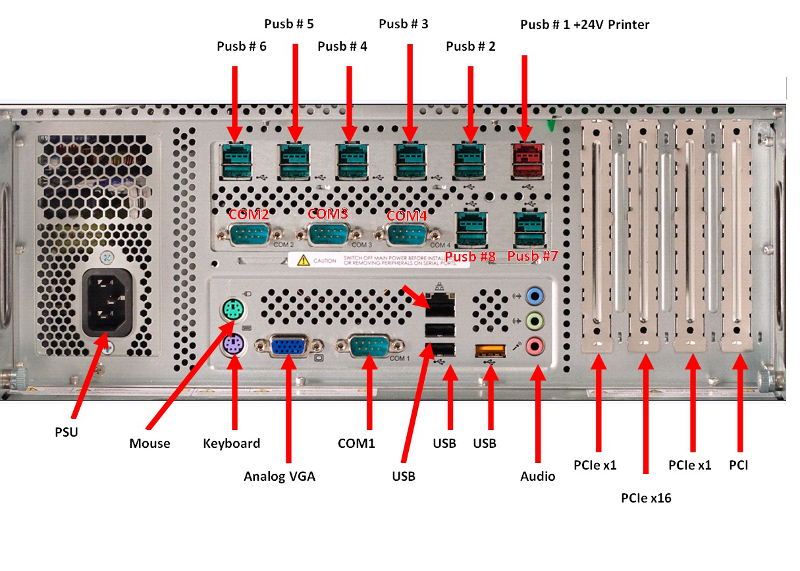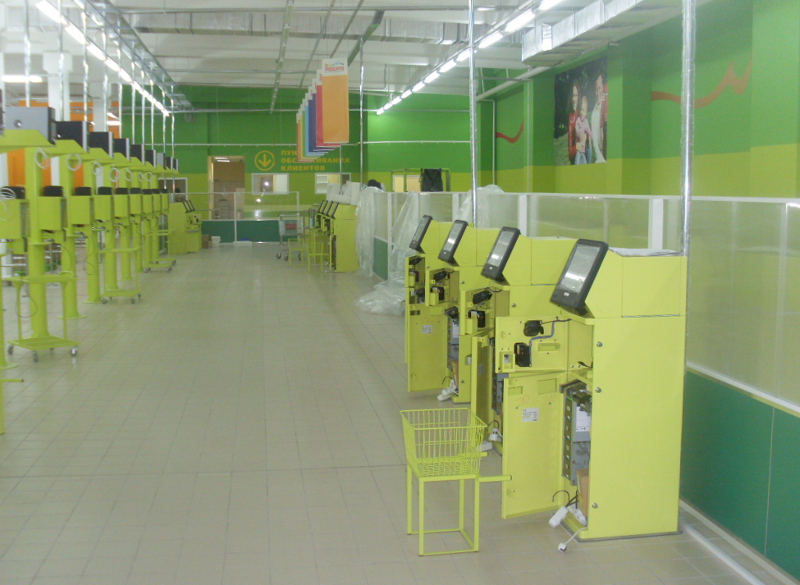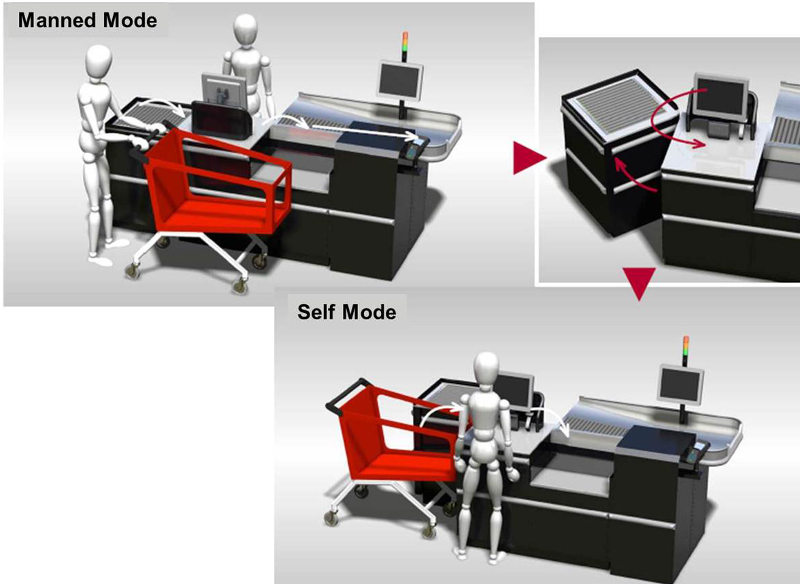A little about self-checkout, they are self-checkouts
In recent years, new devices have entered the retail solutions market - self-service cash registers, or, as they are often called without translation, self-checkouts. It cannot be said that the self-service system began with them, but it is obvious that the future of retail, including self-checkout terminals and the like. The introduction of self-service stores (now we understand - not really self-service!) Was very difficult - just like now - in the case of self-checkouts, there were issues of increasing losses due to theft, label pasting, etc. In this article we want to introduce you closer to self-checkout terminals, tell you what we need, how we work and what tasks of modern retail they solve.

What is a self-checkout from the point of view of a programmer, service engineer, or just a technically oriented person? Appearance may be different depending on the functions that must be performed on the device. Consider a full-featured self-checkout where the customer himself scans barcodes on goods, weighs unmarked fruits or vegetables with a choice of their variety, selects the type of payment and the payment itself in cash, by payment card or other means provided in the store. Variants of devices are possible only with non-cash payment, for a different number of simultaneously filled packages (from one to six), with a conveyor, etc. Typically, such a terminal compares the weight of the scanned product with the reference one using the existing database and, in case of discrepancies, is able to “call” a consultant or administrator for light and sound alarms.
')
The self-checkout includes:
- a cashier’s system unit for the retailer’s standard front-office program (which allows saving on the adaptation of various add-on types of loyalty systems, promotions, etc.), and maybe two - the second to control all devices with an advanced system ports,

- touchscreen monitor for interactive interaction with the buyer,
- acceptors (for acceptance) and dispensers (for change) of bills and coins - with recycling (the ability to give the buyer delivery of the same bills and coins that were previously taken from another buyer) or without it,
- cassette boxes for storing the mentioned bills and coins (depending on the actual trading results, you can change the number and purpose of different cassettes for different bills and coins),
- scanner or scanner-scale to scan the barcode of the product,
- control scales in the package platform,
- several “hangers” for bags - also of different designs, including the so-called “carousel”,
- a device for deactivating anti-theft tags,
- system of the sound and light notification,
- fiscal registrar - a printer for printing checks,
- authorization terminal for servicing payment cards.
In general, it turns out a whole hardware-software complex, all parts of which must be interconnected by at least four software - the cash register program already mentioned, the control program, the graphical user interface with the customer and the software or the firmware of the authorization terminal.
The reliability of the resulting complex is calculated as 1- (1 - R1) * (1-R2) * (1-R3) * (1-R4) * (1-R5), where R1-R4 are the reliability of the mentioned systems, and R5 - reliability of additional mechanical parts. Looking at the formula, it becomes obvious why the world has received mass distribution (and component-wise, and in the collection) solutions only from leading vendors.
In the past few years, realizing that no buyer can scan goods faster than a cashier, retailers are increasingly introducing a hybrid configuration of a cash and settlement node. It involves a quick scan of the goods at the checkout by an experienced and trained cashier, the “forerunner” print with the barcode, and the buyer (both cash and non-cash) will pay for the bill according to the advance payment at a special payment station.

After that, you can use special automatic gates, which allow only the buyer who has already paid for the goods.
Thus, many tasks are solved:
• First, (the dream of any security specialist in retail!), The cashier is removed from the money supply, excluding the possibility of implementing many schemes to deceive the employer
• Secondly, the passage of the buyer through the cash desk is accelerated due to the exclusion of the settlement time with the buyer on it (especially if the response from the payment system is delayed)
• Thirdly, the reliability of checking the authenticity of bills is increased - not a single cashier can, like a scanning device, guarantee the absence of fakes at the cash desk. In addition, the cashier is simply not able to carefully check all bills
• Fourth, it is not necessary to use highly qualified personnel at the box office.
• Fifth, you can automatically track the presence or absence of money at the cashier’s office (even in cash and coinage), adding exchanges or collecting receipts
Along with shops with a combination of ordinary cash desks and self-checkouts, stores appeared where there are no ordinary cash desks at all, the goods are scanned by personnel who do not require training in handling money, and for professionals who find it difficult to pay, specialists will help you.

And this does not exhaust the possibility of varying the configurations. If earlier one of the essential questions was “Is it possible to put back-to-back self-checkouts with the possibility of front-end service?”, Now it is added “Is it possible to turn a self-checkout into a full-fledged cash desk in case of an increased - day or seasonal - the flow of buyers? And if the convenience of a front-end service is already possible to be evaluated by several vendors, then the Fujitsu U-Reverse cash desk with a turntable is still new. It allows for a few seconds to reorient the customer from the passage from the front side of the self-checkout to the rear side, and the cashier to start “unloading” the accumulated queue.

Close to the technology embodied in self-checkouts, the technology of self-scanning with wearable devices abuts. For a long time, in some stores mobile data collection terminals have been introduced, which are issued at the entrance to the self-service hall to customers participating in loyalty programs. As the cart fills, the customer scans the barcodes of goods using the scanner built into the terminal, and when leaving the hall, the cashier takes this device from him, updates the information accumulated in it (however, this can happen online using Wi-Fi networks) and makes cash or cashless settlement with the buyer. So, now "programs" are beginning to include programs that can be installed not on a special terminal, but on a wearable device that almost everyone already has with them - for example, any smartphone. At the same time, in addition to the convenience of service at the checkout, a regular customer can also receive news about promotions in stores, their status in the bonus system, plan a hike through the sales area, etc.
Russian retail has gone the same way in 20 years, which many countries have traveled in 50-60 years, the same applies to the introduction of self-checkouts. And it would be unwise not to use the accumulated alien - both positive and negative - experience!

What is a self-checkout from the point of view of a programmer, service engineer, or just a technically oriented person? Appearance may be different depending on the functions that must be performed on the device. Consider a full-featured self-checkout where the customer himself scans barcodes on goods, weighs unmarked fruits or vegetables with a choice of their variety, selects the type of payment and the payment itself in cash, by payment card or other means provided in the store. Variants of devices are possible only with non-cash payment, for a different number of simultaneously filled packages (from one to six), with a conveyor, etc. Typically, such a terminal compares the weight of the scanned product with the reference one using the existing database and, in case of discrepancies, is able to “call” a consultant or administrator for light and sound alarms.
')
The self-checkout includes:
- a cashier’s system unit for the retailer’s standard front-office program (which allows saving on the adaptation of various add-on types of loyalty systems, promotions, etc.), and maybe two - the second to control all devices with an advanced system ports,

- touchscreen monitor for interactive interaction with the buyer,
- acceptors (for acceptance) and dispensers (for change) of bills and coins - with recycling (the ability to give the buyer delivery of the same bills and coins that were previously taken from another buyer) or without it,
- cassette boxes for storing the mentioned bills and coins (depending on the actual trading results, you can change the number and purpose of different cassettes for different bills and coins),
- scanner or scanner-scale to scan the barcode of the product,
- control scales in the package platform,
- several “hangers” for bags - also of different designs, including the so-called “carousel”,
- a device for deactivating anti-theft tags,
- system of the sound and light notification,
- fiscal registrar - a printer for printing checks,
- authorization terminal for servicing payment cards.
In general, it turns out a whole hardware-software complex, all parts of which must be interconnected by at least four software - the cash register program already mentioned, the control program, the graphical user interface with the customer and the software or the firmware of the authorization terminal.
The reliability of the resulting complex is calculated as 1- (1 - R1) * (1-R2) * (1-R3) * (1-R4) * (1-R5), where R1-R4 are the reliability of the mentioned systems, and R5 - reliability of additional mechanical parts. Looking at the formula, it becomes obvious why the world has received mass distribution (and component-wise, and in the collection) solutions only from leading vendors.
In the past few years, realizing that no buyer can scan goods faster than a cashier, retailers are increasingly introducing a hybrid configuration of a cash and settlement node. It involves a quick scan of the goods at the checkout by an experienced and trained cashier, the “forerunner” print with the barcode, and the buyer (both cash and non-cash) will pay for the bill according to the advance payment at a special payment station.

After that, you can use special automatic gates, which allow only the buyer who has already paid for the goods.
Thus, many tasks are solved:
• First, (the dream of any security specialist in retail!), The cashier is removed from the money supply, excluding the possibility of implementing many schemes to deceive the employer
• Secondly, the passage of the buyer through the cash desk is accelerated due to the exclusion of the settlement time with the buyer on it (especially if the response from the payment system is delayed)
• Thirdly, the reliability of checking the authenticity of bills is increased - not a single cashier can, like a scanning device, guarantee the absence of fakes at the cash desk. In addition, the cashier is simply not able to carefully check all bills
• Fourth, it is not necessary to use highly qualified personnel at the box office.
• Fifth, you can automatically track the presence or absence of money at the cashier’s office (even in cash and coinage), adding exchanges or collecting receipts
Along with shops with a combination of ordinary cash desks and self-checkouts, stores appeared where there are no ordinary cash desks at all, the goods are scanned by personnel who do not require training in handling money, and for professionals who find it difficult to pay, specialists will help you.

And this does not exhaust the possibility of varying the configurations. If earlier one of the essential questions was “Is it possible to put back-to-back self-checkouts with the possibility of front-end service?”, Now it is added “Is it possible to turn a self-checkout into a full-fledged cash desk in case of an increased - day or seasonal - the flow of buyers? And if the convenience of a front-end service is already possible to be evaluated by several vendors, then the Fujitsu U-Reverse cash desk with a turntable is still new. It allows for a few seconds to reorient the customer from the passage from the front side of the self-checkout to the rear side, and the cashier to start “unloading” the accumulated queue.

Close to the technology embodied in self-checkouts, the technology of self-scanning with wearable devices abuts. For a long time, in some stores mobile data collection terminals have been introduced, which are issued at the entrance to the self-service hall to customers participating in loyalty programs. As the cart fills, the customer scans the barcodes of goods using the scanner built into the terminal, and when leaving the hall, the cashier takes this device from him, updates the information accumulated in it (however, this can happen online using Wi-Fi networks) and makes cash or cashless settlement with the buyer. So, now "programs" are beginning to include programs that can be installed not on a special terminal, but on a wearable device that almost everyone already has with them - for example, any smartphone. At the same time, in addition to the convenience of service at the checkout, a regular customer can also receive news about promotions in stores, their status in the bonus system, plan a hike through the sales area, etc.
Russian retail has gone the same way in 20 years, which many countries have traveled in 50-60 years, the same applies to the introduction of self-checkouts. And it would be unwise not to use the accumulated alien - both positive and negative - experience!
Source: https://habr.com/ru/post/235793/
All Articles